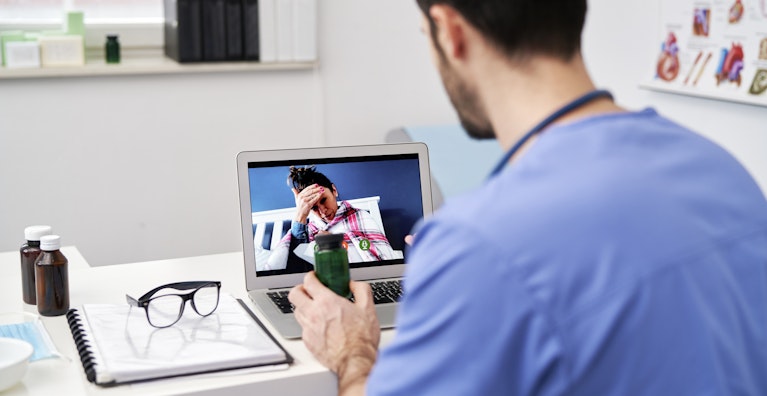Telemedicine as an Industry
Author: Dr. Namita Singh
Telemedicine is referred to as remote delivery of health care services using advanced telecommunications technology. It allows health care professionals to evaluate, diagnose and treat patients at a distance using electronic audio and video means. Telemedicine has been trending since the COVID- 19 pandemic as it allowed people to communicate with physicians without requiring a patient to come into a doctor’s clinic. The fear of individuals exposing them to the virus has encouraged them to adopt this technology quickly. However, the roots of telemedicine can be traced back centuries and today it is used by more than 50% hospitals in the United States.
The concept of telemedicine is not new, in fact, it has been in use since the 19th century, when telegraph was used to order medical supplies as well as reporting casualties and injuries during the U.S. Civil War. In 1950’s, two health centers in Pennsylvania about 24 miles apart were able to transmit first radiologic images via telephone line. Then, in 1959, clinicians at the University of Nebraska transmitted neurological examinations across campus to medical students using two way interactive television.

Today, due to the ongoing crisis, healthcare institutes consider telemedicine services as an ideal solution to prevent exposure to the virus. Just like a regular doctor’s appointment, telemedicine services are also private and confidential.
What are the benefits of Telemedicine?
- Telemedicine allows doctor-patient communication in real time and prevents non-urgent healthcare visits. The patient doesn’t have to take a day off for an appointment.
- Telemedicine can overcome geographical barriers. People from rural areas can have access to varied specialty services without travelling long distances for an in-person visit.
- It is cost effective as it saves the collateral cost of hospital stay and commute.
- It eliminates unnecessary ER visits which further reduce exposure to contagious patients.
- Availability of patient electronic medical record (EMR) makes prescription more accurate and reliable and allows patients to connect with their doctor more frequently.
- Telemedicine providers like Credence Medicure allows patients to seek a second opinion from experts.
Limitations
Telemedicine does have few downsides, such as: * With telemedicine, it is not possible to conduct tests that require hands- on examination. You may still need an in-person appointment for the clear diagnosis. * Only few services are covered under insurance. * Telemedicine certainly decreases the doctor- patient interaction which might concern those looking for a family doctor.

Is Telemedicine the same as Telehealth?
No, many people even healthcare providers often use Telemedicine and Telehealth interchangeably. Basically, telemedicine is a subset of telehealth. Telehealth refers to remote non-clinical services such as continuing education of healthcare providers and consumers, research and evaluation whereas telemedicine refers to remote clinical services.
How to connect to a healthcare provider?
As technology has advanced, the way telemedicine is delivered has also changed. Consultation doesn’t necessarily require a computer. All you need is an electronic device (mobile phone, tab or laptop) with good internet connection and a secure patient portal with Electronic Medical Record (EMR) capabilities. After logging into the portal you will fill in some personal details and medical history and then schedule an appointment with the services you need. The remote patient will be connected to a registered medical practitioner at the selected time slot. Services can be provided through video conferencing, e-mail or phone messaging. However, at Credence we mainly prefer video conferencing for the better and easier communication. We remind and update patients regarding their consultations via email. Upon completing the consultation, your doctor will provide you with the Electronic Medical Report.
When to use Telemedicine?
Telemedicine can be used for anything from consulting a physician for conditions as small as allergy to receiving a birth control prescription. However, it should not be used in emergency conditions such as heart attack or a condition that requires hands- on examination. Telemedicine is suitable for allergies, Covid-19 screening, Diabetes, Hypertension, Depression/ Anxiety, Seasonal flu, Blood Pressure, Constipation, Nutrition counselling, Physical Therapy, Psychotherapy.
Source:
Share this on Social media
HEALTH DISCLAIMER
This blog provides general information and discussions about health and related subjects. The information and other content provided in this blog, or in any linked materials, are not intended and should not be construed as medical advice, nor is the information a substitute for professional medical expertise or treatment.
The content is for information purpose only and is not a medical advice. Qualified doctors have gathered information from reputable sources; however Credence Medicure Corporation is not responsible for errors or omissions in reporting or explanations. No individual should use the information, resources and tools contained herein to self diagnose or self treat any medical condition.
If you or any other person has a medical concern, you should consult with your health care provider or seek other professional medical treatment. Never disregard professional medical advice or delay in seeking it because of something that have read on this blog or in any linked materials. If you think you may have a medical emergency, call your doctor or emergency services immediately.
The opinions and views expressed on this blog and website have no relation to those of any academic, hospital, health practice or other institution.
Credence Medicure Corporation gives no assurance or warranty regarding the accuracy, timeliness or applicability of the content.
comments powered by Disqus

